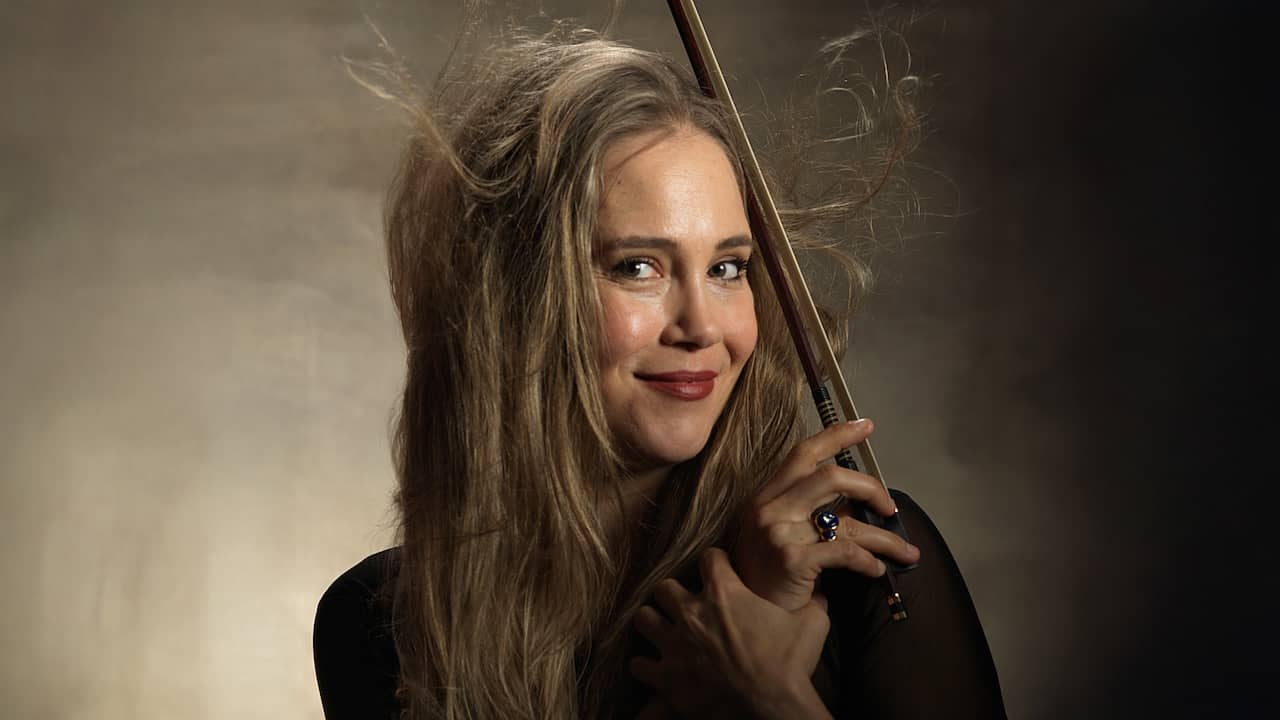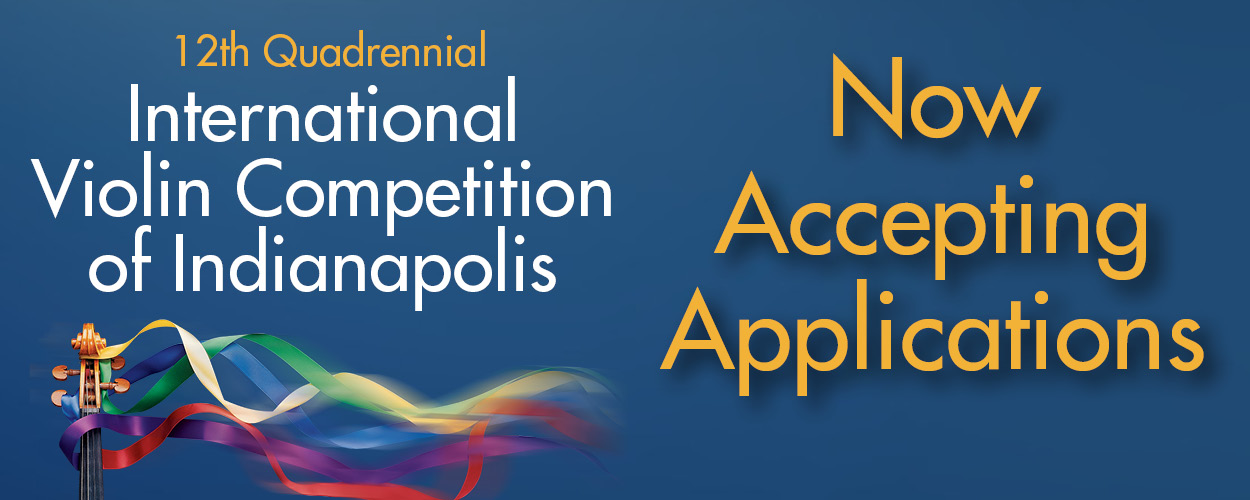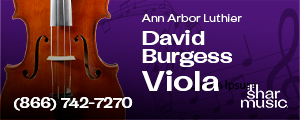Interview with Violinist Leila Josefowicz: Being Open to New Music
When it comes to new music, violinist Leila Josefowicz has some advice: "Feel it and hear it, and be open," she said. "That's all. You don't have to 'get it.'"
Over her career Josefowicz has become an absolute force for new music. She has the technique and intellect to find meaning in the thorniest of new scores - and she also has the gutsy and audacious stage presence to transform them into thrilling live performances.
But how did she get there? From prodigy to fierce advocate for new music - this was not a straightforward path. "It took many years, figuring that all out," Leila told me, during a Zoom interview in October. "I had a very strange start to my career.

Violinist Leila Josefowicz. Photo by Tom Zimberoff.
Friday marks the release of a new recording that has great meaning for her - her performance of Thomas Adès' Violin Concerto with the Minnesota Orchestra, under the baton of Music Director Thomas Søndergård. Josefowicz is a longtime champion of the work, having performed it internationally for more than 20 years.
On the eve of this release Josefowicz spoke with me about her unusual path, about how her connection with contemporary music and composers grew so strong, what she loves about music that many find difficult to understand, and why the Adès concerto has become a signature of her repertoire.
Josefowicz was born near Toronto, then when she was three her family moved to the Los Angeles area (Malibu) for her father's job as a research physicist. Age three is when she started playing the violin, with the Suzuki method.
"Violin was always my father's obsession," she said. It took a great deal of time and transformation, before it became hers.
"It's a strange and amazing story - a lot of parents have dreams for their children," she said. It's less common for those dreams to transform into something that the child owns - for it to become their dream. "That's actually what happened with me. I went through the trenches of the prodigy years and came out the other side."
Josefowicz studied with the Colburn School's Robert Lipsett from age eight to 13 - and that's when she not only advanced in her violin technique, but she had a quick and early introduction to Hollywood.
"He knew a lot of studio musicians and producers, people who hosted various events, gala evenings, TV shows..." Josefowicz said. As a result of his connections and of her family's location in Los Angeles - the heart of the entertainment industry - the pre-teenaged Josefowicz was invited to play in a good number of popular television shows and programs. "I was on one of Johnny Carson's last shows, and I was on the Smothers Brothers show. I was on the Mickey Mouse Club. Probably the biggest show I did was a gala event for Leonard Bernstein - I played a with Dudley Moore, and Bernstein gave me this big hug on stage."
"It was very odd," she said, but she didn't know any differently. "Only as I digested these years did I really kind of start to understand what it all meant."
In 1988, "I was part of a production that was televised internationally, called America's Tribute to Bob Hope," she said. You can see it here on YouTube - the very-young Josefowicz was introduced by Lucille Ball and performed Wieniawski's Scherzo-Tarantelle, receiving a standing ovation from an audience that included then-president Ronald Reagan and his wife, Nancy.
"This was a show that was seen by people around the world, including in Europe and the UK," Josefowicz said. "The head of IMG management saw it, and called their New York office and said, 'Sign her!'"
"This was very unorthodox way to start a career," she said, and it coincided with starting her studies at the Curtis Institute of Music. "It was pretty odd to sign with IMG artists while just beginning at Curtis," she said.
Being a prodigy had afforded her some advantages - for example "my first full-size instrument was a Guarneri del Gesù from Bein and Fushi (the Stradivari Society)." (She now has two modern violins - both by Sam Zygmuntowicz - 2013 and 2019.)
With so many T.V. appearances as well as a recording contract under her belt already, the live performing part of her career "started relatively slowly," she said. "My main real concertizing was just beginning in those years, and really started to increase as I went through the teens.
Today, Josefowicz has three sons, ages 25, 13 and 11 - and "when I look back and see what I was doing at all these different ages, it's kind of crazy," she said. It was a lot, for someone so young. "It took many years for me to digest things," she said.
But when it came to the question of whether or not to continue in this profession, whether she could make it her own choice, "one of the big answers for me had to do with picking my own repertoire," Josefowicz said.
"I had kind of already gone through a lot of the standard rep at that point," she said, "but I was always attracted to and edging towards the more contemporary music." For example, at Curtis she played things like the Bartok Solo Sonata; and at the Marlboro Music Festival, she played the Bartok Quartet. "I studied more and more with Felix Galimir," she said. "He was very important to me." Galimir personally had known the composer Alban Berg, and "I learned a lot of Berg from him: the Lyric Suite, Violin Concerto..."
"At that time in Curtis, basically nobody was playing music this new," she said. "Times have really changed at Curtis, they're doing much more than they used to do. But this was in the early 90s. When I was there, it was old school."
Then Josefowicz had a life-changing breakthrough - she had the opportunity to work with the composer John Adams. It's a relationship that remains today.
It all started when she fell in love with Adams' Violin Concerto and wanted to perform it. No, she insisted on performing it.
"I was listening around, and Gidon Kremer had just come out with a recording of John Adams' Violin Concerto on Nonesuch," Josefowicz said. "I found it a very interesting piece, in many ways. The last movement is (Adams') quintessential sound. But the other movements I also found very interesting. And I thought, hey, let's give this a shot."
Her management, however, resisted the idea. The then-new piece already had been premiered, why perform it, if the premiere had already been done?
Josefowicz's response: "If we treated every piece this way, no piece would have a life at all!"
She got her way. They planned a performance with the Vermont Symphony, then a second performance a few months later, with the Seattle Symphony. And for the Seattle performance, the composer was in the audience.
"John came to that," she said. "We had met maybe once before, very briefly, but this time he was actually hearing me play his piece."
"I thought he liked it - I wasn't totally sure quite how much," she said. The answer came a couple of weeks later: he contacted her management and wanted to conduct a half-dozen concerts the following seasons, with her playing his Violin Concerto.
"In the life of a musician, this was about as life-changing as things could get," she said. "This was just the start of the many amazing composers that I got to meet and work with: Oliver Knussen, Thomas Adès, Luca Francesconi, Steven Mackey, Colin Matthews... Esa-Pekka Salonen was ready to write a violin concerto, and there I was. It was serendipitous timing, in many ways."
After spending so much time studying and performing pieces by composers from past centuries, what was it like to work with a living composer on a piece that was just written?
"It was amazing," Josefowicz said. "I was so used to just having this sense of removal...and then all of a sudden, you can go out for pizza with the composer!"
It was a time when a great many gifted and important composers were ready to jump-start a big piece, and Josefowicz was more than happy to collaborate. "I realize now, how amazing this whole 20 years has been," she said, "and this is why I also feel very lucky."
In the early 2000's Josefowicz met the composer Thomas Adès through Oliver Knussen, with whom she had been working for about five years. Adès' Violin Concerto (which originally subtitled "Concentric Paths") was commissioned by the Los Angeles Philharmonic and Berlin Festspiele and premiered in 2005 by violinist Anthony Marwood.
"I remember getting the manuscript score of the 'Concentric Paths' - it hadn't even quite been published yet," Josefowicz said. "It was amazing to see the score, it was just so beautiful. It wasn't written for me; it was written for a fellow colleague, Anthony Marwood. But I just fell so deeply in love with this piece, and I really wanted to learn it and play it."
Adès was becoming more and more recognized, so people wanted to hear the violin concerto.
Josefowicz first performed Adès' Violin Concerto shortly after its premiere, and by now she has given around 100 performances of it - performing it for three or four orchestra series concerts every year.
"I've been living with this piece for all of those years," she said. "It's amazing to have played this piece for basically its entire life, 20 years, solidly - almost every single season. Lots of times, and lots of different interpretations."
"Conductors, of course, are very important in this piece - or with any piece of 20th- or 21st-century music," Josefowicz said. "With the newer scores, there is a complexity with ensemble, with various rhythms, possibly with counter rhythms and all kinds of things going on." These are not the kinds of pieces one would consider conducting while playing - "the extremes of my part - and also the extremes in their parts - make it totally impossible for me to consider ever playing or conducting at once," she said. "Sometimes my part is so complicated rhythmically that I visually need to see a beat, so that I can make sure that I'm with everyone.
She doesn't memorize every modern piece she plays, but Josefowicz has memorized the Adès Violin Concerto, as it can get very complicated to toggle between looking at the score, looking at what you're doing and looking at a conductor.
"There's so much going on; it's better to have less things to look at than to have more," she said. "But you definitely need an extra person there, to help navigate."
Certainly the sound world of Adès three-movement Violin Concerto is not like any kind of traditional violin concerto. My impressions, listening to Josefowicz's new recording with the Minnesota Orchestra: the first movement "Rings" features notes on the solo violin that are on the extreme - even perhaps alarming - end of high; the second movement, "Paths," has rather menacing double-stops and gestures that get darker as the movement moves on, ending like a large beast going back to its cave. The final movement, "Rounds," begins with a kind of dark dance, with the violin line feeling melodic and soaring - at least for a time - until its starts circling into a frenzy of motion.
BELOW: Josefowicz performing the first movement, "Rings," of Thomas Adès' Violin Concerto.
It's possible to conjure all kinds of images and impressions from this music. What does Josefowicz think about, when playing and interpreting this kind of piece?
"What fascinates me about these newer scores are just extraordinary sounds that can be produced and invented," Josefowicz said. "To me, it's very inspiring to always be hearing new sounds - truly new sounds." She remains in awe of the composers she works with - while they perhaps draw on some ideas from Ligeti or Stravinsky, it takes great originality and intellect to invent such completely new sound palettes.
"The composers that I work with are incredible minds, to make up these sounds," she said. Occasionally something like a story can help her form an interpretation, "but usually I go by sounds. I try to make them as powerful as possible. The score is like a map. If it's a great score, if it's clear, all you have to do is to really do it. People don't always 'really' do it, they 'sort of' do it. They 'kind of' do it. You have to 'really' do it, and make it very, very clear, what you're trying to say."
When you get a score and decide it's a beautiful score, how do you get from there to the point of "really" doing it?
"You see what's there, and you practice, you learn. It becomes part of your body. It has to become internalized," she said. "Then you see what this composer has asked, then you take it to a level that you find so convincing that no one would have any questions about it. That is what I hope to do."
"If it's a textural passage where things are really blurry, or really atmospheric, or really mysterious - you really have to give this feeling, to communicate it in whatever way that means. You have to make it real, with physicality. Otherwise, this is all up in your head."
"A real artist can take it and make it real for people," she said. "What I hope to do is to be so convincing that people are drawn in and fascinated. I hope to preempt them, before they get to this stage of, 'Do I get it?' You don't need to 'get it.' There's nothing to get. You just have to experience it."
Josefowicz loves to hear the comment "I've never heard anything like that before," from an audience member after a performance. "Then I feel like we're doing what we need to be doing in music," she said. "We're so used to things that are familiar, and we're so used to the pieces that we already know and love. But we have to stay adventurous and open."
You might also like:
- Violinist.com Interview with Leila Josefowicz and Esa-Pekka Salonen: Violin Concerto 'Out of Nowhere' (2012)
- Leila Josefowicz: Around the World with Esa-Pekka Salonen's 'Out of Nowhere' Violin Concerto
- Interview in Aspen with Augustin Hadelich: the Ligeti Violin Concerto (2018)
* * *
Enjoying Violinist.com? Click here to sign up for our free, bi-weekly email newsletter. And if you've already signed up, please invite your friends! Thank you.
Replies
Thank you for sharing this interview!
This article has been archived and is no longer accepting comments.
Violinist.com is made possible by...
International Violin Competition of Indianapolis
Violinist.com Holiday Gift Guide
Dimitri Musafia, Master Maker of Violin and Viola Cases
Johnson String Instrument/Carriage House Violins
Subscribe
Laurie's Books
Discover the best of Violinist.com in these collections of editor Laurie Niles' exclusive interviews.

Violinist.com Interviews Volume 1, with introduction by Hilary Hahn

Violinist.com Interviews Volume 2, with introduction by Rachel Barton Pine









November 16, 2025 at 04:32 PM · {#1} As from ~ Elisabeth Matesky, Violin "Apostle" of both Jascha Heifetz & Nathan Milstein, also Veteran Concert Touring Artist after her London Wigmore Hall April 1967 Debut signed under then Wilfrid Van Wyck Concert Artist Management, Ltd, in 80 Wigmore Street, London, W1 on same Concert Roster of Violinists with Ruggiero Ricci, Henryk Szeryng and Nathan Milstein, also following being a Laureate of 1st Sibelius International Violin Competition, circa 1965, held in Helsinki, FI, also SIVC *Special Awardee for "Most Outstanding Unaccompanied Bach in Violin" w/Invite from Madam Sibelius, then ailing aged 92, yet honoured to be invited to offer her Finnish fabled Husband Composer's Violin Concerto "Prayer" Movement, "Adagio di molto", for The Finnish Government Official Inaugural Concert & Ceremony with The Finnish Minister of Culture proclaiming the Birth-House of Jean Sibelius, in Hameenlinna, FI, the "Sibelius National Memorial Museum" following our performance w/Finnish SIVC Official Pianist, Mary Lakos, and myself with Eurovision + 6 other Int'l TV Co's on Sibelius' Centenery BD 8th of December, 1965, Live televising our Performance, squished in a corner of the very tiny Birth-House of Finnish Titan Composer, Sibelius, termed "The Most Moral" Composer since Ludwig van Beethoven, with his Epic Violin Concerto being earlier championed by my Iconic Violin Mentor, GOAT Jascha Heifetz on all of Mr. Heifetz's Beyond Praised International Concert Tours and with a First Recording of "The Sibelius" with British fabled Conductor, Sir Thomas Beecham and the LPO, which would later in **1959 seem very 'pale' in scope when JH then re- recorded Sibelius' Violin Concerto here in Chicago in our Medinah Temple gloried acoustics with the Chicago Symphony Orchestra under then MD, Fritz Reiner, who took very ill, with his Associate Conductor, *Walter Hendl, stepping in at a Last Moments notice known as a friendly to Soloist's Conductor, with what is now known as the GOAT Recording of Sibelius Violin Concerto 33 RPM's ~ Heifetz/CSO/Hendl Sibelius V.C. (RCA Red Seal) & with loyal A & R Man to Heifetz, Jack Phifpher as Recording Engineer which featured prominently due the rare circumstances of the 'Final Take' and Non Stop with No interruptions of what my CSO playing Colleagues shared with me of the utterly brilliant and beyond all Universal 'Borders' Performance of Jascha Heifetz, after his requested One Hour Break to JH practise=1 Hour in a Room then returning to the Recording and requesting the Engineer turn on the Dials to record his hoped for {Last Try} in a Specific following Order of Movements: Firstly 2nd Slow Mvt, "Adagio di molto" followed by Devilish 3rd Mvt, "Allegro ma non tanto" and directly into the 1st Mov't without Any Stops in-between & once concluded, Mr. Heifetz took his Guarneri del Gesu Violin placing it in its lush Violin Case to Jack Phifpher's Question to Heifetz: "Mr. Heifetz, Sir, prior to leaving, would You like to hear the Play Backs?" to JH's kind words to his friend of over 25 + years, "No, Jack! Thank You, I don't need to hear it. Just let this one Go Out!!" Unparalleled in Recording Annals, the Jascha Heifetz Sibelius with Chicago Symphony Orchestra/Walter Hendl Cond Recording is considered The GOAT JH Epic Sibelius Violin Concerto Beyond All Others!! My Point for opening my EM Reply re *Leila Josefowicz in her New Recording of the Thomas Ades Violin Concerto is to point out the Daring Mt. Everest Peaks of Epic Performance of Heifetz, undisputed GOAT Violinist of All Centuries **Second recording at the time of first published Recording of Jean Sibelius' Violin Concerto in 1930s London earlier (Beecham/LPO/JH) versus #2 which clarifies later 'Newer' Sounding and 'Defiant' Violin Concerto of Rare JH Sounds; Innuendi and Mountainous Violin technical difficulties with All overcome and "Owned" by Jascha Heifetz, whom I am sure Ms Josefowicz knows and has always long admired!
With All Relevant Above Said, I'm truly intrigued by Leila's Journey from her Ingenue Days as a young "Prodigy" to young artist and journeying through her Life and musically growing to the point of recognising and embracing the Violin Scores of Alban Berg, btw, World Premiered in NYC, by *Louis Krasner, Brother In Law of LJ's Mentor, *Felix Galimir (superb artist in violin with whom Leila studied and learned invaluable ideas from her must have been usually stretched out musical 'tutorials', aka, lessons) about the Alban Berg Violin Concerto re Galimir's Sister- Wife of US Violinist, *Louis Krasner's NYC World Premiered Alban Berg much earlier and Prior to I am now educated guessing, her Birth and to grand acclaim globally!! In fact, if Leila Josefowicz, might read my EM Reply *knowing her from a recital she presented under the auspices of *The Stradivari Society with myself writing about her Concert for 'the Strad' long ago* she might enjoy knowing about an intriguing Family Relationship of my much Elder Colleague in Syracuse, NY, Professor of Violin @Syracuse University, *Louis Krasner, and who invited yours truly to Take his Large Class of 22 Violinists whilst he took an extended & earned Sabbatical when I was honoured Violin Soloist & Concertmaster of then Syracuse Symphony, titled Artist Teacher of Violin & Chamber Music at NY State's Syracuse University for the Sabbatical of Professor of Violin Louis Krasner, the recognised Great American Violinist w/Galimir's Sis', *Adrian Krasner in the Principle Second Violin role in the Syracuse Symphony under Music Conductor, Frederick Prausnitz, who was most daring in his S.S. Orchestra Programming of newer '70s nearly all contemporary rhythmically complex works for the Orchestra Of & including US Composer, *Karel Hrusa, who lived to Aged 100 having his Intellect works performed all over New York State and in Carnegie Hall regularly by Bernstein and the like (not Like Bernstein in Stature) but by globally admired other Conductors of the Podium! Dating myself a touch, it does help when I have quiet opportunity to re-read the Full Interview of Editor here of Violinist.com online Journal, *Laurie Niles, who IMO has done a really wonderful Job of interviewing now Mother of *Three w/even 1 Child over 20, Mom Leila Josefowicz!!! I wish to compliment Laurie Niles for her keen and inquisitive well done Interview with one of our American now Seasoned Virtuoso Violinists also introspective Musicians, and whom on First Hearing here in Chicago with Founder, *Geoffrey Fushi, of The Stradivari Society, asking I attend to write up LJ's debut recital in a smaller venue in a Chic private Club on Michigan Ave in this Club and well attended by Donors of the Stradivari Society names which elude me now but Will remember any names to return here adding on to my EM Reply {#1}!!
With some time restraints right now, I do greatly look forward to hearing the New Recording of Leila Josefowicz in The Ades Violin Concerto 1st Mvt and will return hopefully if this Blog is Not Closed, to share my EM Impressions of Leila's Violinistic performance and her musicality with I'm sure some unique New Inserts of Sounds which from her words of wisdom re New Music and embracing it minus All "Getting It"!! (Agreed!) plus a few words from an Older Violinist Colleague who knew her playing in I believe 1980s/90s and her artistry Now in Anno 2025!!
Alert! I just listened to the First Movement of the Thomas Ades Violin Concerto New Recording of his rare and uniquely marvellously interpreted & performed 1st Mvt by Wondrous Violinist, Ms Leila Josefowicz, rising up & going down the fingerboard when the Full Orchestral Composition requires the Composer, Ades' tremendous differing 'Opinions' in Sound adroitly 'Owned' by Ms. Josefowicz in Grand Olympic Violin Form! I am convinced this 1st Mvt Work is Mandatory to hear from what I listened to Twice so interested by its Final Huge Bass Drum Question Mark? w/Thud purposefully inserted by Composer, Thomas Ades and invisibly mirrored by Superb 'Reply' from Violin Soloist, Leila Josefowicz!! I relish hearing the Next 2 Movements which must be 21st Century Surprised yet framed in Classically 'approved' by noted Music Historians and very knowledgeable Critics!!! I sense 'Father Ades' should make Josefowicz the Dedicatee! With Sincerely surprised Admiration! Elisabeth Matesky {Amended 18.11. 2 0 2 5}
With early Thanksgiving Greetings to Laurie Niles and Family, I remain ~
~ ~ ~ Yours respectfully with Gratitude for L.J. New Music ~ ~ ~
............ Musically from Chicago, Elisabeth Matesky ............
Fwd ~ dmg {#1} *Save Book File Violinist.com LN w/L. Josefowicz '25*